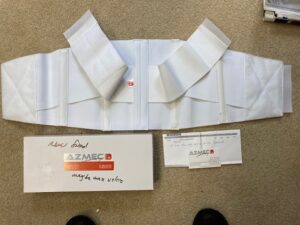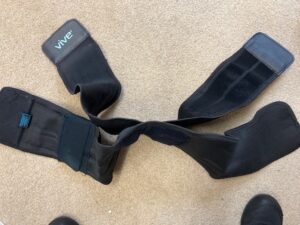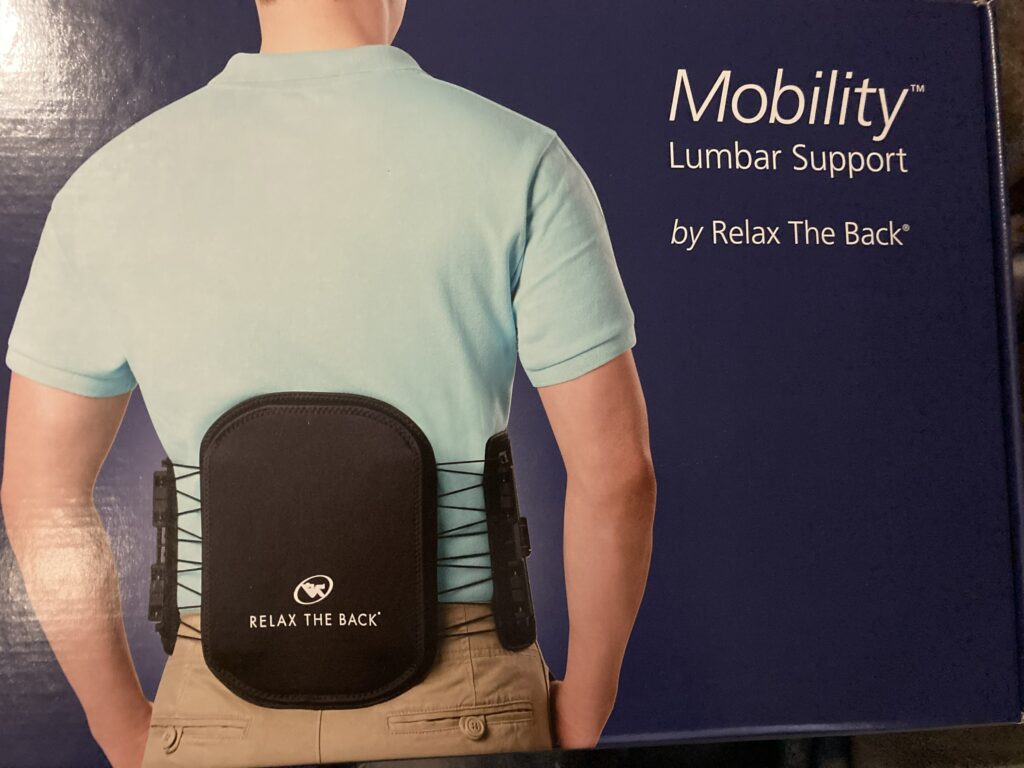
by Rick Whitehead, Knoxville, Tennessee
I’d like to share one of the most valuable tips I’ve had for dealing with “FSHD belly.” My abdominal core muscles had become like weak balloons, displacing internal organs. It’s not comfortable, not attractive and sometimes painful. I was in a clinical trial in Rochester, New York, and had a session with the physical therapist, Kate Eichinger. When I mentioned my weak core, she simply said, “Google ‘double compression support belts’.” While that may seem overly broad, it was perhaps the best advice, because there are so many choices. Each individual must refine their search based on their needs. I’ll describe the ones that have worked for me, after much trial and error, modification, and a small expense.
The benefit has been tremendous. I was spiraling down, with more frequent lower back injuries, weight gain, and fatigue. The belt replaces the support lost in the core muscles. The vertical stays in the back and the double compression in the front actually correct the lordosis (back curvature) to a degree—straightening me right up. I immediately feel the support and stabilization. I look fit and trim too, as the belt is easily hidden under clothing.
Keep looking until you find ones that work for you
Fortunately, the belts are not that expensive, mostly around $35, so I’ve been able to try many over the years. Many were useless, and none is perfect, but some have greatly improved my quality of life. I basically use three different belts depending on the season and the work or situation. I wear my belts during all waking hours, so I’m crouching, bending, sitting, etc., and each belt behaves differently. The biggest flaw with all of them is that they tend to fold over when I bend. I’ve been able to modify the belts to minimize this effect, but they all eventually wear out, and will show wear and tear at the fold line.

My favorite is by Azmec. It is latex-free, breathable, expandable, can be next to the skin, and can cover the whole abdominal area. You can find them on the “lumbosacral supports” page of their website. Originally, they ran around $35, and I tried four versions. Now they charge me $70 for each of the modifications I request (to help prevent the folding over). Still, for me they are the best belt and company. You need to be willing to try different belts and work with Oscar (email me for his info).
The main drawback of the Azmec belt is that it is somewhat difficult to put on. Lying down (best on a hard surface like the floor, but obviously easier on a bed) relaxes and flattens the abdominal area and makes it easier to put on the belt. It requires some arm strength to pull the compression straps. I can manage this, but it may be more difficult for others.

Another belt I use is the “Vive”, which I found on Amazon. It is much easier to put on, even while standing, and the straps are a little easier to pull into place. It is flexible and very strongly supportive, but it can be too hot to wear during summer, so I mainly use it in cooler seasons.
The third belt was an expensive model from Relax The Back. This belt has parachute cords to cinch it in place. You don’t need much strength to pull these, and it releases and adjusts quickly. My local Relax The Back store has closed but I recently found a belt on their website that I tried out (see below). It’s expensive but it works great. It’s easy to adjust the tightness using the fastners in front and the parachute cords on the back. I’m very happy with it.
The benefits of these belts have been life-changing for me. It does take persistence to find one that works for you. I am happy to share details of my experience. You can contact me at whiteheadrick8@gmail.com.



Hi Rick, I enjoyed the FSHD Radio with you as a guest. I’ve had a few different belt with varying success. But the front rollover is a problem. When you said it helped you to walk again, that caught my attention. As did the study in Ohio, no age limit, being 73 now I hope to find out more?id like to go into this a little more with you, as your time allows. I’ll be trying to set up more P/T to work on my standing upright so the braces will help. I wasn’t diagnosed until I was 65. It was evident when I was a teen & my early 20s but none of my Drs said anything? So I was fortunate in I led a fairly normal life. I’ve noticed it more since my hip replacement in Dec2017. But when you mentioned your abs, the light went on! That maybe that was more of my problem than my lower back? My last year or so in the factory I began to notice that I was handling the steel stock with more difficulty loading and unloading the presses I was operating. Bending way backwards to try to balance the weight. My good hip began acting up about 6 months after the replacement in the other hip. I thought at first, as did my P/Ts, that because my right leg was carrying most of the load now that the other hip was good, it was just reacting to not having to work as hard. About this time my right thigh began to feel unstable and a little weaker. I went from one cane to two canes to now a walker and a scooter for longer distances. But if I can get back to some walking that would be a big plus! See you Monday